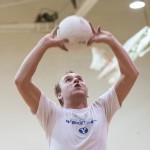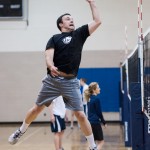BYU students taking activity classes may have realized one of two things: either playing up a skill level causes improvement or playing down a level causes laziness.
Now that advanced activity classes are no longer offered at BYU, students with a wide variety of skill levels are enrolling in intermediate classes. Some students are taking the intermediate class after taking the beginning class and feeling ready for the next level. On the other hand, many students take intermediate classes for the opportunity to play a sport they know and love.
The only sport that still has an advanced class is tennis. According to BYU’s student wellness website, the sports that offer both beginning and intermediate classes are basketball, golf, racquetball, skating, hockey, soccer, skiing, swimming, SCUBA, tennis and volleyball.

As fun as the advanced classes were, the goal of student activity courses is “to learn and to get better,” according to Glenna Padfield, who is the director of student activity classes at BYU. Padfield said many students use these classes as somewhat of an open gym, which is not the purpose of student activity courses.
For many students, however, student activity classes are a great way to get their exercise in for the day while having fun. Josh Hawkins, a senior English major from Spokane, Wash., has taken the intermediate volleyball class six times. Not only has he improved each semester, but he likes having a set time to play the sport he loves.
“Nobody is playing during open gym, at least not enough,” Hawkins said. “(Class) is a regular thing. You can take it twice a week to go play volleyball. We don’t have volleyball in Spokane, so it’s kind of nice to go through and learn, do drills.”
As beneficial as intermediate volleyball classes have been to Hawkins, he would really enjoy taking an advanced class.
“I think advanced would be better because it gets rid of the people who have taken beginning and take intermediate, but they shouldn’t be,” Hawkins said. “I guess it’s open enrollment, so you can’t guarantee that. But it’s just better volleyball.”
Most people do not have many complaints about intermediate classes, but if they do, it is about the discrepancy between the skill levels. Some students feel as if they improve, but then as they continue to take the class, they cannot move up any further. One such student is Chris Yegge, a senior Spanish translation major from Prescott, Ariz. Yegge took beginning volleyball before moving on to intermediate, which he has taken multiple times. He would like the chance to move up another level, but without advanced classes, this isn’t an option.
“I feel like I’ve definitely gotten better since I’ve taken intermediate (volleyball),” Yegge said. “Some classes I feel like I don’t even try because the level isn’t that good. … (Intermediate) is the highest they have, and I want to keep playing.”
Not everyone is complaining about the wide range of skill levels in intermediate classes. Those students who came from beginning classes are being exposed to a lot of experienced students, which has the potential to be both difficult and beneficial to them.

Jacob Neeley, a freshman studying industrial design from Frazier Park, Calif., is an example of how intermediate classes help students grow. Neeley took beginning volleyball during a summer term, then decided to take the intermediate class during winter semester to challenge him more. The class, though challenging, has taught him a lot about volleyball.
“I think that even though I can’t compare to a lot of the players in intermediate, I’m definitely learning more and adapting better just because you have to be faster and be more consistent,” Neeley said. “It makes you actually play harder than if you were playing with people that are as good or aren’t as good.”
The lack of advanced student activity classes is beneficial for those without a lot of experience playing that particular sport, like Neeley, though other students might be frustrated. The instructors of these classes are able to see the needs of both skill levels and try to teach everyone to close the gap between the experienced and less experienced students. Sarah Ingbresten, an exercise science graduate student from Salt Lake City, has taught soccer and basketball classes, and she has been able to see different skill levels, though it is not always apparent.
“It really just depends on the class,” Ingbresten said. “I had one semester where there were huge discrepancies. … That was a little bit rough for me to plan things that would help both groups get better. That was just one semester though. On average, I would say that the skill level is similar enough.”




